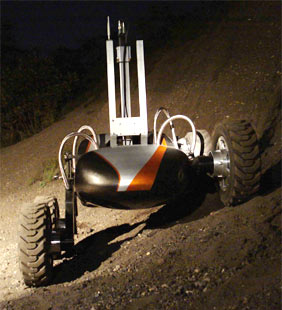
Image at left: This robot shares some features with the lunar truck [below after the jump], but is equipped with a drill designed to find water and oxygen-rich soil on the moon. Credit: Carnegie Mellon University
The moon has one-sixth the gravity of Earth, so a lightweight rover will have a difficult job resisting drilling forces and remaining stable. Lunar soil, known as regolith, is abrasive and compact, so if a drill strikes ice, it likely will have the consistency of concrete. Meeting these challenges in one system requires ingenuity and teamwork. Engineers used this lunar rover to demonstrate a drill capable of digging samples of regolith. The demonstration used a laser light camera to select a site for drilling then commanded the four-wheeled rover to lower the drill and collect three-foot samples of soil and rock.
In 2008, the team plans to equip the rover with ISRU’s Regolith and Environment Science and Oxygen and Lunar Volatile Extraction experiment, known as RESOLVE. Led by engineers at NASA’s Kennedy Space Center, Fla., the RESOLVE experiment package will add the ability to crush a regolith sample into small, uniform pieces and heat them.
The process will release gases deposited on the moon’s surface during billions of years of exposure to the solar wind and bombardment by asteroids and comets. Hydrogen is used to draw oxygen out of iron oxides in the regolith to form water. The water then can be electrolyzed to split it back into pure hydrogen and oxygen, a process tested earlier this year by engineers at NASA’s Johnson Space Center in Houston.
“We’re taking hardware from two different technology programs within NASA and combining them to demonstrate a capability that might be used on the moon,” said Gerald Sanders, manager of the ISRU project. “And even if the exact technologies are not used on the moon, the lessons learned and the relationships formed will influence the next generation of hardware.”
Some, all or none of these features may be selected to be in the design of a rover that eventually goes to the moon. NASA’s lunar architects currently envision pressurized rovers that would travel in pairs, two astronauts in each rover. The new prototype vehicle is meant to provide ideas as those future designs are developed.

Brian Wang is a Futurist Thought Leader and a popular Science blogger with 1 million readers per month. His blog Nextbigfuture.com is ranked #1 Science News Blog. It covers many disruptive technology and trends including Space, Robotics, Artificial Intelligence, Medicine, Anti-aging Biotechnology, and Nanotechnology.
Known for identifying cutting edge technologies, he is currently a Co-Founder of a startup and fundraiser for high potential early-stage companies. He is the Head of Research for Allocations for deep technology investments and an Angel Investor at Space Angels.
A frequent speaker at corporations, he has been a TEDx speaker, a Singularity University speaker and guest at numerous interviews for radio and podcasts. He is open to public speaking and advising engagements.




Comments are closed.